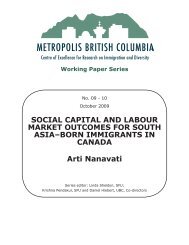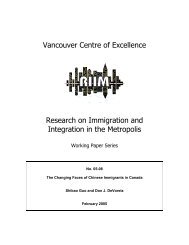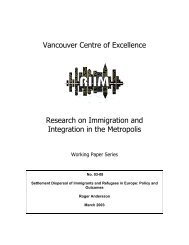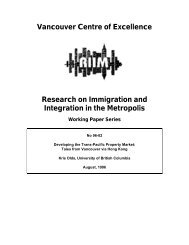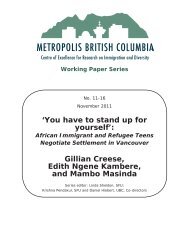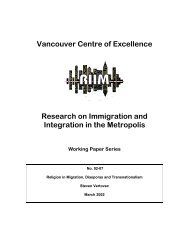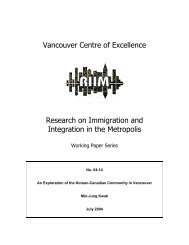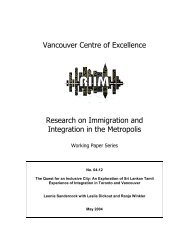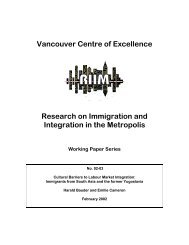Characteristics of Immigrant Transnationalism in ... - Metropolis BC
Characteristics of Immigrant Transnationalism in ... - Metropolis BC
Characteristics of Immigrant Transnationalism in ... - Metropolis BC
You also want an ePaper? Increase the reach of your titles
YUMPU automatically turns print PDFs into web optimized ePapers that Google loves.
17<br />
Table 10: Transnational activities by identification as Canadian<br />
Family Keep Travel Job Property Bus<strong>in</strong>ess Send $<br />
<strong>in</strong> home <strong>in</strong> to home requires <strong>in</strong> home <strong>in</strong> home to home<br />
number* country touch country travel country country country<br />
Always 462 85.4 93.6 71.3 6.8 18.3 1.8 11.2<br />
Most <strong>of</strong> the time 399 91.2 93.4 70.6 7.3 17.0 1.5 13.4<br />
Sometimes 309 93.2 97.9 70.9 3.8 20.0 2.9 18.3<br />
Occasionally 110 93.6 97.1 60.0 20.0 32.7 3.7 21.3<br />
Never 160 95.0 98.7 59.4 16.7 45.9 10.8 15.8<br />
Probability 0.001 0.011 0.001 0.030 0.000 0.000 0.044<br />
* Total number <strong>in</strong> the survey; the number answer<strong>in</strong>g each question is different and less than the total <strong>in</strong>dicated here.<br />
Indicates highest value<br />
Indicates lowest value<br />
Columns pr<strong>in</strong>ted <strong>in</strong> a light tone <strong>in</strong>dicate non-significant results <strong>in</strong> chi-squared tests.<br />
Discussion<br />
We would not expect transnational practices to be the same <strong>in</strong> any two places. Much <strong>of</strong> the American<br />
research has been undertaken <strong>in</strong> southern California and the cities <strong>of</strong> the East Coast. Those migrants are<br />
typically <strong>of</strong> modest means and travel between relatively close orig<strong>in</strong>s <strong>in</strong> Central America and the<br />
Caribbean and their homes <strong>in</strong> the United States. In Vancouver, <strong>in</strong> contrast, recent immigration is<br />
dom<strong>in</strong>ated by sources <strong>in</strong> East Asia, pr<strong>in</strong>cipally Ch<strong>in</strong>a, Hong Kong, Taiwan and Korea, South-east Asia,<br />
notably the Philipp<strong>in</strong>es and Vietnam, and South Asia, pr<strong>in</strong>cipally India. Older migration is from<br />
Europe. Movement between Vancouver and these orig<strong>in</strong>s is long and can only be undertaken by air, an<br />
expensive means <strong>of</strong> transport. Distance and cost are bound to affect the easy movement <strong>of</strong> transnational<br />
migrants.<br />
It is <strong>in</strong>structive to compare the <strong>in</strong>cidence <strong>of</strong> transnational activities <strong>in</strong> Vancouver with a<br />
longitud<strong>in</strong>al panel survey undertaken <strong>in</strong> Montreal (Renaud et al. 2002). In the fourth round <strong>of</strong><br />
<strong>in</strong>terviews with some 300 immigrants ten years after arrival, 96 percent <strong>of</strong> respondents had family <strong>in</strong><br />
their home country, compared with 90 percent <strong>in</strong> Vancouver who specified they had friends or family <strong>in</strong><br />
their home countries. Of the Vancouver sample, 68 percent had travelled to their home country at least<br />
once, close to the Montreal figure <strong>of</strong> 72 percent. There were also surpris<strong>in</strong>gly similar likelihoods <strong>of</strong><br />
own<strong>in</strong>g property <strong>in</strong> the country <strong>of</strong> orig<strong>in</strong> (22 percent <strong>in</strong> Vancouver, 24 percent <strong>in</strong> Montreal), and <strong>of</strong><br />
own<strong>in</strong>g a bus<strong>in</strong>ess there (3.2 percent <strong>in</strong> Vancouver, 2.3 percent <strong>in</strong> Montreal). In contrast remittances<br />
were sent by far fewer Vancouver immigrants, only 14 percent, compared with figures rang<strong>in</strong>g between<br />
28 percent and 67 percent <strong>in</strong> the four rounds <strong>of</strong> the Montreal panel (Renaud et al. 2002).



